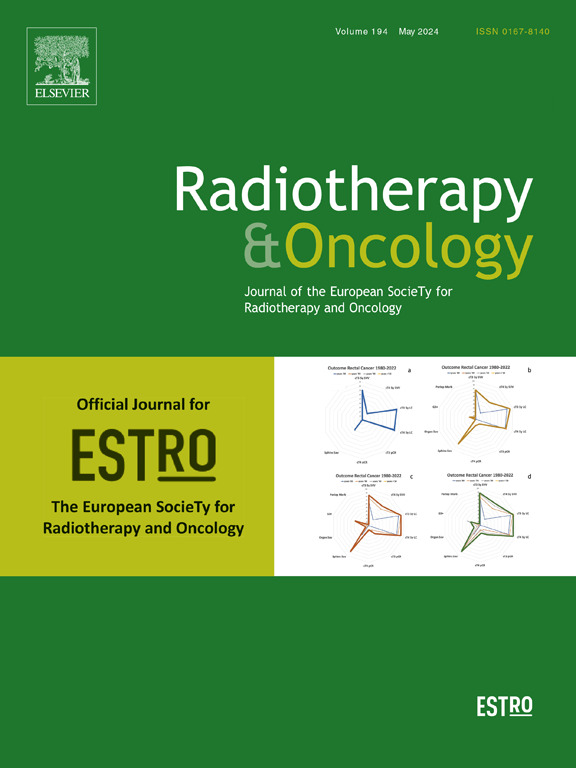放疗对局部晚期口腔鳞状细胞癌下颌骨节段切除和即刻重建中骨性游离皮瓣的重要影响:一项队列研究
IF 4.9
1区 医学
Q1 ONCOLOGY
引用次数: 0
摘要
背景和目的晚期局部口腔鳞状细胞癌(OSCC)R0切除术后的标准放疗方案以及节段性缺损的初次重建,都会对自体微血管游离皮瓣的健康组织施加高剂量辐射。考虑到皮瓣并发症和相关手术可能给患者带来的后果,目前还缺乏关于是否需要对皮瓣进行术后放疗(PORT)的数据。材料与方法回顾性分析了2012年至2022年间因晚期OSCC而进行下颌骨节段切除并立即用无骨皮瓣重建的患者的总生存期(OS)、无病生存期(DFS)、无局部失败生存期(LFFS)、二次手术需求以及皮瓣并发症,并以皮瓣并发症的发生率为主要终点,通过配对方法比较了有PORT和无PORT的患者。结果105名患者符合纳入标准,最长随访时间为60个月。68例患者接受了PORT治疗。74例患者纳入最终分析。无一例游离皮瓣内疾病复发。两组患者的 DFS(p = 0.21)、OS(p = 0.33)和 LFFS(p = 0.6)无明显差异。照射皮瓣的骨坏死(p = 0.03)和骨暴露(p = 0.003)发生率较高。PORT患者因皮瓣并发症而进行二次手术的需求明显增加(p = 0.009)。结论PORT与晚期OSCC较高的皮瓣并发症和二次手术需求有关。鉴于皮瓣内无PORT的复发率为零,且在健康的移植组织内复发的可能性不大,因此对这一脆弱组织应用高剂量辐射是否有用值得怀疑。应在 RCT 试验中对 RT 计划的进一步改进进行评估和测试。本文章由计算机程序翻译,如有差异,请以英文原文为准。
A critical reflection of radiotherapy on osseous free flaps in mandibular segmental resection and immediate reconstruction in locally advanced oral squamous cell carcinoma: A cohort study
Background and purpose
With standard radiotherapy protocols after R0 resection of advanced local oral squamous cell carcinoma (OSCC) and primary reconstruction of segmental defects, a high radiation dose is applied to healthy tissue in autologous microvascular free flaps. Considering the potential consequences of flap complications and associated surgeries for patients, data is lacking on whether postoperative radiotherapy (PORT) of the flap volume is indicated at all.
Materials and methods
Patients with segmental mandibular resection and immediate reconstruction with osseous free flaps due to advanced OSCC between 2012 and 2022 were analyzed retrospectively regarding overall (OS), disease-free survival (DFS), local failure-free survival (LFFS), the need for secondary surgeries as well as flap complications and compared between patients with and without PORT in a matched-pair approach with occurrence of flap complications as a primary endpoint.
Results
105 patients matched the inclusion criteria. The maximum follow-up period was 60 months. 68 patients received PORT. 74 patients were included in the final analysis. No case of disease recurrence inside the free flap was recorded. There were no significant differences in DFS (p = 0.21), OS (p = 0.33) and LFFS (p = 0.6) between both cohorts. Occurrence of osteoradionecrosis (p = 0.03) and bone exposure (p = 0.003) was higher in irradiated flaps. In patients with PORT, the demand for secondary surgeries due to flap complications was significantly higher (p = 0.009). Radiation doses were not increased in patients with flap ORN.
Conclusion
PORT is associated with higher flap complications and need for secondary surgeries in advanced stage OSCC. Given a recurrence rate of zero inside the flap without PORT and the improbability of recurrence within healthy transplanted tissue, the usefulness of applying high radiation doses to this vulnerable tissue is questioned. Further refinements of RT planning should be evaluated and tested in a RCT trial.
求助全文
通过发布文献求助,成功后即可免费获取论文全文。
去求助
来源期刊

Radiotherapy and Oncology
医学-核医学
CiteScore
10.30
自引率
10.50%
发文量
2445
审稿时长
45 days
期刊介绍:
Radiotherapy and Oncology publishes papers describing original research as well as review articles. It covers areas of interest relating to radiation oncology. This includes: clinical radiotherapy, combined modality treatment, translational studies, epidemiological outcomes, imaging, dosimetry, and radiation therapy planning, experimental work in radiobiology, chemobiology, hyperthermia and tumour biology, as well as data science in radiation oncology and physics aspects relevant to oncology.Papers on more general aspects of interest to the radiation oncologist including chemotherapy, surgery and immunology are also published.
 求助内容:
求助内容: 应助结果提醒方式:
应助结果提醒方式:


